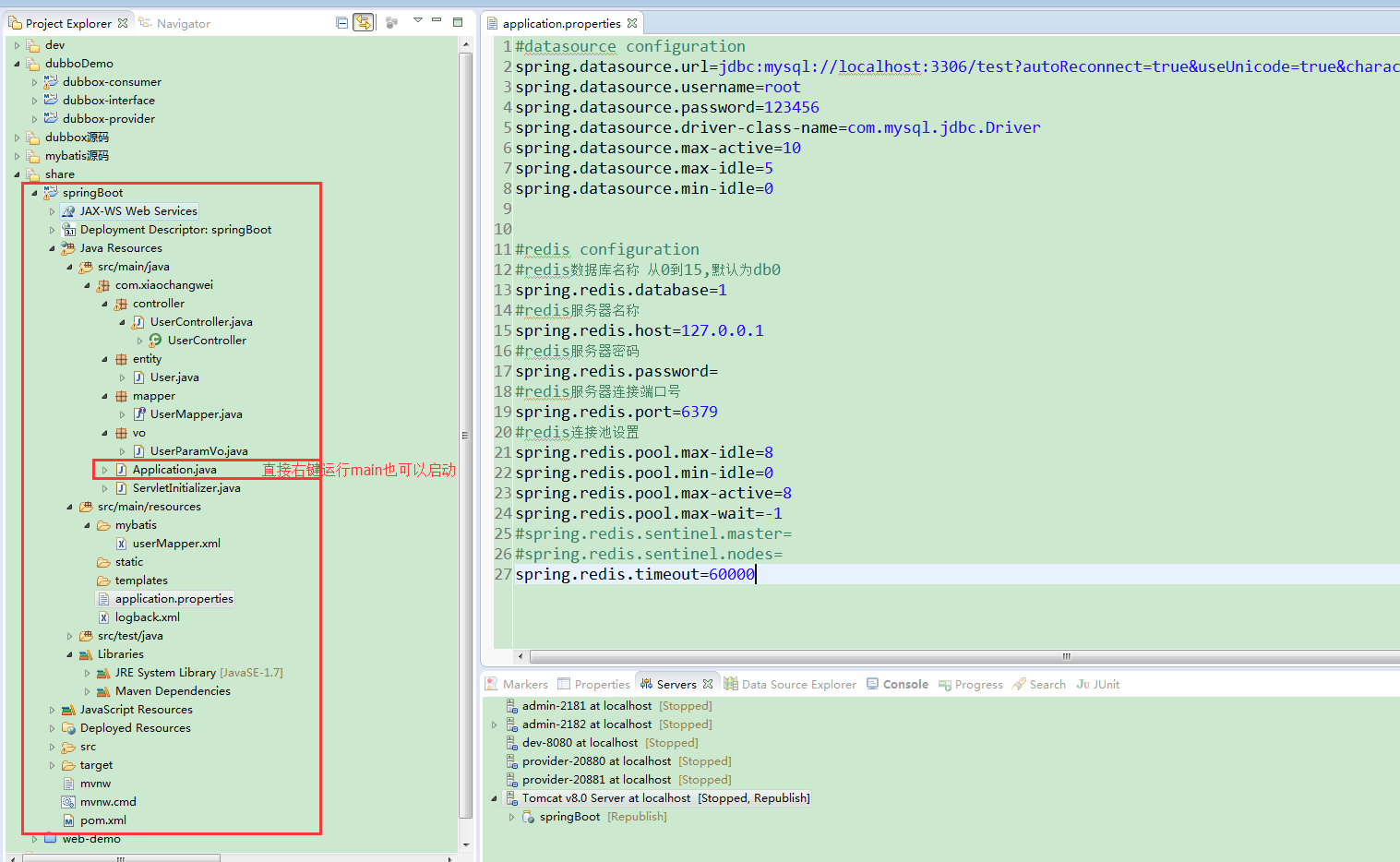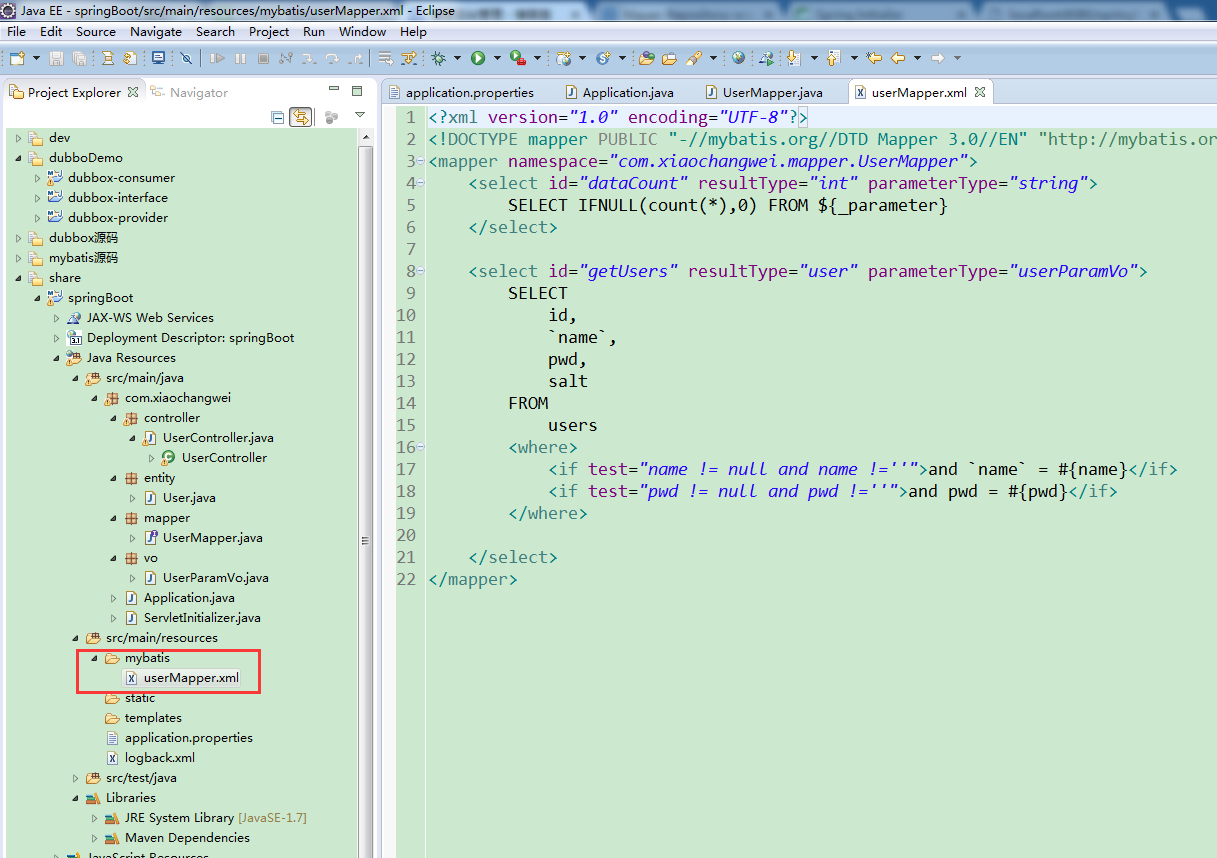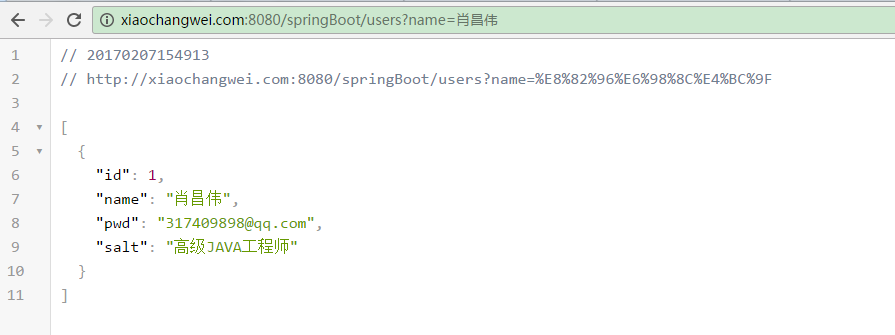SpringBoot 入門教程:整合mybatis,redis
SrpingBoot相較於傳統的專案具有配置簡單,能快速進行開發的特點,花更少的時間在各類配置檔案上,更多時間在具體業務邏輯上。
SPringBoot採用純註解方式進行配置,不喜歡xml配置的同學得仔細看了。
首先需要構建SpringBoot專案,除了傳統的自己構建好修改pom中依賴外,spring提供了更便捷的專案建立方式

勾選自己需要用到的東西,這裡我們構建標準的web專案,同時裡面使用到了mybatis,mysql,redis為例項進行建立,根據專案需要自己勾選相關專案,生成專案後並匯入到Eclipse等開發工具中,
注意:打包方式有jar和war, 如果要部署在tomcat中,建議選擇war
匯入後的專案已經是標準的web專案,直接通過tomcat部署訪問或者執行application.java的main方法,啟動後訪問一切正常。

增加資料庫訪問和mybatis相關操作配置:
1.首先在application.properties中增加資料來源配置
#datasource configuration spring.datasource.url=jdbc:mysql://localhost:3306/test?autoReconnect=true&useUnicode=true&characterEncoding=utf8&zeroDateTimeBehavior=convertToNull spring.datasource.username=root spring.datasource.password=123456 spring.datasource.driver-class-name=com.mysql.jdbc.Driver spring.datasource.max-active=10 spring.datasource.max-idle=5 spring.datasource.min-idle=0
2.修改Application.java,設定mapper介面掃描路徑和mybatis對應的xml路徑,還可以設定別名的包路徑等
已經資料來源,事物等
以前這些都需要自己在xml裡面配置,現在直接程式碼操作就好了,極大的減少了
修改後的程式碼如下: 注意紅色框內內容,根據需要酌情修改

3.定義操作資料庫的mapper,這裡需要注意的是,mapper上面不再需要@Repository這樣的註解標籤了
package com.xiaochangwei.mapper; import java.util.List; import com.xiaochangwei.entity.User; import com.xiaochangwei.vo.UserParamVo; /** * @since 2017年2月7日 下午1:58:46 * @author 肖昌偉 [email protected] * @description */ public interface UserMapper { public int dataCount(String tableName); public List<User> getUsers(UserParamVo param); }
4.定義放在對應目錄下的mapper.xml檔案

5.由於同時使用了redis,在application.properties中也加入redis相關配置
#redis configuration #redis資料庫名稱 從0到15,預設為db0 spring.redis.database=1 #redis伺服器名稱 spring.redis.host=127.0.0.1 #redis伺服器密碼 spring.redis.password= #redis伺服器連線埠號 spring.redis.port=6379 #redis連線池設定 spring.redis.pool.max-idle=8 spring.redis.pool.min-idle=0 spring.redis.pool.max-active=8 spring.redis.pool.max-wait=-1 #spring.redis.sentinel.master= #spring.redis.sentinel.nodes= spring.redis.timeout=60000
6,最後寫Controller程式碼,由於僅僅是測試,就沒有什麼規範可言了,直接調dao,方式和以前一樣,這裡沒啥變更
package com.xiaochangwei.controller; import java.util.List; import javax.annotation.Resource; import org.slf4j.Logger; import org.slf4j.LoggerFactory; import org.springframework.beans.factory.annotation.Autowired; import org.springframework.data.redis.core.RedisTemplate; import org.springframework.data.redis.core.StringRedisTemplate; import org.springframework.data.redis.core.ValueOperations; import org.springframework.web.bind.annotation.PathVariable; import org.springframework.web.bind.annotation.RequestMapping; import org.springframework.web.bind.annotation.RequestMethod; import org.springframework.web.bind.annotation.RestController; import com.xiaochangwei.entity.User; import com.xiaochangwei.mapper.UserMapper; import com.xiaochangwei.vo.UserParamVo; /** * @since 2017年2月7日 下午2:06:11 * @author 肖昌偉 [email protected] * @description */ @RestController public class UserController { protected static Logger logger = LoggerFactory.getLogger(UserController.class); @Autowired private UserMapper userDao; @RequestMapping("/count/{tableName}") public int dataCount(@PathVariable String tableName) { return userDao.dataCount(tableName); } @RequestMapping(value = "/users", method = { RequestMethod.GET }) public List<User> users(UserParamVo param) { return userDao.getUsers(param); } @Autowired private StringRedisTemplate stringRedisTemplate; @Resource(name = "stringRedisTemplate") ValueOperations<String, String> valueOperationStr; @RequestMapping("/redis/string/set") public String setKeyAndValue(String key, String value) { logger.debug("訪問set:key={},value={}", key, value); valueOperationStr.set(key, value); return "Set Ok"; } @RequestMapping("/redis/string/get") public String getKey(String key) { logger.debug("訪問get:key={}", key); return valueOperationStr.get(key); } @Autowired RedisTemplate<Object, Object> redisTemplate; @Resource(name = "redisTemplate") ValueOperations<Object, Object> valOps; @RequestMapping("/redis/obj/set") public void save(User user) { valOps.set(user.getId(), user); } @RequestMapping("/redis/obj/get") public User getPerson(String id) { return (User) valOps.get(id); } }
至此,程式碼就編寫完了,啟動專案後訪問測試
1.查詢全部使用者資訊(無引數時)

2.根據引數查詢

3.redis設值

4.redis取值

至此,springboot中使用mybatis操作mysql資料庫和操作redis全部完成,需要原始碼的同學可以發郵件到的郵箱,我會盡快傳送給你
本文僅做簡易的學習測試,更多內容敬請期待後續相關文章
下一篇將講解springCloud入門
相關推薦
SpringBoot 入門教程:整合mybatis,redis
SrpingBoot相較於傳統的專案具有配置簡單,能快速進行開發的特點,花更少的時間在各類配置檔案上,更多時間在具體業務邏輯上。 SPringBoot採用純註解方式進行配置,不喜歡xml配置的同學得仔細看了。 首先需要構建SpringBoot專案,除了傳統的自己構建好修改
SpringBoot學習:整合Mybatis,使用HikariCP超高性能數據源
sta 掃描 sap url compile ack 項目結構 連接 style 一、添加pom依賴jar包: 1 <!--整合mybatis--> 2 <dependency> 3 <groupId>org.mybat
SpringBoot學習:整合MyBatis,使用Druid連線池
專案下載地址:http://download.csdn.NET/detail/aqsunkai/9805821 (一)新增pom依賴: <!-- https://mvnrepository.com/artifact/org.mybatis.spring.boot/m
2.SpringBoot入門教程之整合slf4j日誌配置
SpringBoot入門教程之整合slf4j日誌配置 Java日誌框架眾多,常用的有java.util.logging, log4j, logback,commons-logging等等。個人比較偏好的是slf4j,同時也比較偏好使用字尾為.propertie
SpringBoot入門系列:第四篇 redis
一,準備工作,建立spring-boot-sample-redis工程 1、http://start.spring.io/ A、Artifact中輸入spring-boot-sample-redis B、勾選Web下的web C、勾選NOSQL
springboot整合mybatis,mysql做資料庫儲存,redis做快取
redis應用的場景通過快取來減少對關係型資料庫的查詢次數,減輕資料庫壓力。在執行DAO類的select***(), query***()方法時,先從Redis中查詢有沒有快取資料,如果有則直接從Redis拿到結果,如果沒有再向資料庫發起查詢請求取資料。springboot已
springboot-整合mybatis-mysql-redis-quartz,到redis整合時就報錯
. ____ _ __ _ _ /\\ / ___'_ __ _ _(_)_ __ __ _ \ \ \ \( ( )\___ | '_ | '_| | '_ \/ _` | \ \ \ \ \\/ ___)| |_)| | | | | || (_| | )
第三節,SpringBoot整合shrio,Redis快取session與許可權
1.建立Springboot專案 省略。。。 pom檔案 <?xml version="1.0" encoding="UTF-8"?> <project xmlns="http://maven.apache.org/POM/4.0.0" xmlns:xsi="htt
SpringBoot整合mybatis,及SpringBoot中的junit測試
1、pom檔案中引入mybatis依賴:mybatis-spring-boot-starter 和mysql驅動依賴:mysql-connector-java,以及spring-boot-starter-test依賴用於junit測試
springboot 2.0 教程-05-整合mybatis
閱讀原文:https://blog.bywind.cn/articles/2018/11/28/1543373589258.html 視訊教程:https://www.bilibili.com/video/av35595465 課程原始碼:https://github.com/ibywind/s
Spring Boot 基礎系列教程 | 第十六篇:整合MyBatis
推薦 Spring Boot/Cloud 視訊: 最近專案原因可能會繼續開始使用MyBatis,已經習慣於spring-data的風格,再回頭看xml的對映配置總覺得不是特別舒服,介面定義與對映離散在不同檔案中,使得閱讀起來並不是特別方便。 Spring中整合
微服務 SpringBoot 2.0(九):整合Mybatis
我是SQL小白,我選Mybatis —— Java面試必修 引言 在第五章我們已經整合了Thymeleaf頁面框架,第七章也整合了JdbcTemplate,那今天我們再結合資料庫整合Mybatis框架 在接下來的文章中,我會用一個開源的部落格原始碼來做講解
springboot整合MyBatis,Unsatisfied dependency expressed through field 'payParamMapper'
最近在做專案時候,使用springboot+mybatais時候,遇到下面這個問題,一時大意,記錄下異常資訊和解決方式 org.springframework.beans.factory.UnsatisfiedDependencyException: Erro
springboot 整合mybatis,mapper介面和對應的mapper對映檔案放在同一個包下的配置
一、springboot整合mybatis後,需要進行幾個步驟的配置: 1、mapper包下的mapper介面都需要新增@Mapper註解。 2、啟動類上面新增@MapperScan(basepackages={"com.web.mapper"})註解。 3、需要在po
SpringBoot 2.x(三):整合Mybatis的四種方式
前言 目前的大環境下,使用Mybatis作為持久層框架還是佔了絕大多數的,下面我們來說一下使用Mybatis的幾種姿勢。 姿勢一:零配置註解開發 第一步:引入依賴 首先,我們需要在pom檔案中新增依賴: 第二步:配置檔案 這裡我們採用yml來進行編寫,與properties檔案相比,yml看
SpringBoot 2.x(五):整合Mybatis-Plus
簡介 Mybatis-Plus是在Mybatis的基礎上,國人開發的一款持久層框架。 並且榮獲了2018年度開源中國最受歡迎的中國軟體TOP5 同樣以簡化開發為宗旨的Spring Boot與Mybatis-Plus放在一起會產生什麼樣的化學反應呢?下面我們來領略一下兩者配合帶來的效率上的提升。 Myba
springboot微服務搭建(一):整合mybatis配置(第一種方式)
現在看網上springboot整合mybatis有兩種方式:第一種是使用maven的mybatis的依賴,填寫配置檔案;第二種是採用spring-mybatis的配置。 第一種,在已有的springboot專案的pom檔案中加入 <dependency>
React Native基礎&入門教程:以一個To Do List小例子,看props和state
本文由葡萄城技術團隊於部落格園原創並首發 轉載請註明出處:葡萄城官網,葡萄城為開發者提供專業的開發工具、解決方案和服務,賦能開發者。 在上篇中,我們介紹了什麼是Flexbox佈局,以及如何使用Flexbox佈局。還沒有看過的小夥伴歡迎回到文章列表點選檢視之前的文章瞭解。 那麼,當我們有了基本
一起來學 SpringBoot 2.x | 第七篇:整合 Mybatis
點選上方“芋道原始碼”,選擇“置頂公眾號”技術文章第一時間送達!原始碼精品專欄 摘要: 原創出處
使用SpringBoot搭建小型專案,整合mybatis,redis,swagger2,並部署在外部容器中。
一 簡介 初次接觸springboot,最直觀的感受是搭建專案幾乎不需要任何配置檔案,自帶Tomcat容器,節省了很多開發和部署時間,專案也變得更加精簡。 SpringBoot主要特性: 1 spring Boot Starter:它將常用的依賴分組進行了整合,將其合
